Why Cots Sheets Matter for Safety, Comfort, and Hygiene
Cots sheets are specialized fitted or flat bedding made for the narrow mattresses you find in daycare centers, RV bunks, summer-camp cabins, and professional facilities. Because standard twin sheets hang loose and bunch up, a properly sized cot sheet is essential for both hygiene and safety.
Common Cot Sheet Sizes
- Toddler/Daycare: 52" × 22" (U.S. rest-cot standard)
- Camping/RV: 30" × 75" (narrow twin)
- Custom: Built to match specialty frames
Main Types
- Fitted sheets with elastic corners
- Basic flat sheets
- All-in-one attached top sheets
- Single-use disposable options
Key Materials
- Durable cotton/poly blends
- Soft 100 % cotton
- Hypoallergenic or antimicrobial fabrics for sensitive users
When the fit is right, a cot sheet acts as a hygienic barrier, boosts comfort, and lets staff remake a bed in seconds. We have seen facilities cut replacement costs in half simply by upgrading to sturdy poly-cotton options with reinforced elastic.
As American Mortuary Coolers, we routinely advise funeral homes, childcare centers, and camps across the contiguous 48 states. Our takeaway is simple: invest once in the correct material and size, and you avoid constant re-ordering and trip-hazards caused by loose fabric. For background on how cots themselves evolved, see this overview on Wikipedia).
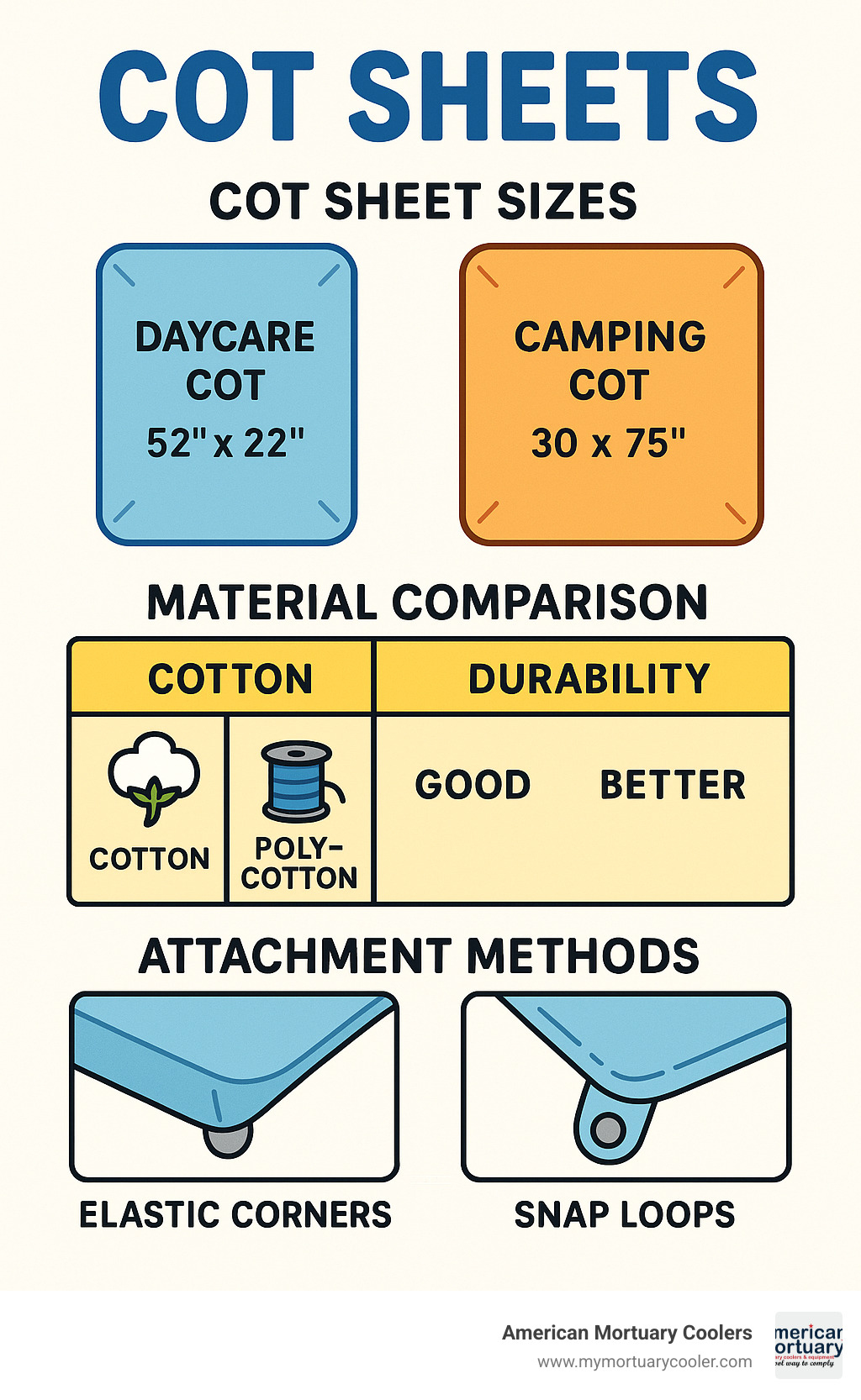
What Are Cots Sheets?
Think of cots sheets as the specialized cousin of regular bed sheets - they're designed for those narrow sleeping surfaces that leave standard twin sheets looking like oversized blankets. While your typical twin sheet measures 39 inches wide, cot sheets are custom for surfaces ranging from just 22 to 30 inches wide.
You'll find these specialized sheets working hard in daycare centers where little ones need their afternoon rest, at summer camps where kids sleep on narrow bunks, and yes, even in our industry - funeral homes and mortuaries where professional presentation matters. Scientific research on sleep hygiene shows that maintaining clean sleeping surfaces directly impacts sleep quality and health - especially for children. These sheets serve as your first line of defense against germs, allergens, and the everyday wear that can turn expensive cot mattresses into costly replacements.
We've worked with facilities across the country, from Tennessee to California, and the story is always the same: proper cots sheets mean fewer hygiene headaches and equipment that lasts years longer than expected.
Key Functions of Cots Sheets
The barrier hygiene function is probably the most important thing these sheets do, even though it's invisible. Every time someone lies down, they're transferring skin cells, oils, and potentially germs to the surface. In daycare settings, where the same cot might host three different toddlers in a week, this protection becomes absolutely critical.
As a comfort layer, quality cot sheets transform what can be a pretty unforgiving sleeping surface into something actually cozy. We've heard from daycare directors who say the difference between bare cots and properly fitted cotton sheets is like night and day - literally affecting how well children sleep during rest time.
But here's where the rubber meets the road: quick change capability. When accidents happen (and in daycare settings, they absolutely will), having properly fitted sheets means your staff can strip, sanitize, and remake a cot in under two minutes.
Types of Cots Sheets
Fitted sheets with elastic corners are the workhorses of the cot sheet world. These feature elastic bands or corner loops that grip the cot securely, eliminating that frustrating sheet-slippage that makes everyone's job harder. The Lakeshore Cot Sheet, which customers rate at 4.6 out of 5 stars, uses this tried-and-true design with elastic corner bands for what users consistently describe as a "snug, secure fit."
Flat sheets offer simplicity and usually cost less, but they're honestly more trouble than they're worth in high-use situations. They work fine as top sheets or in guest rooms where they won't see daily use, but for busy facilities, fitted is the way to go.
Attached top sheets represent some clever thinking in the bedding world. Products like the Happi-Nappi Standard Cot Sheet combine a fitted bottom sheet with a permanently attached top coverlet. No more hunting for matching pieces, no more lost top sheets, and bed-making becomes a one-step process.
Disposable options serve very specific needs, particularly in medical and mortuary settings where preventing cross-contamination is non-negotiable. These single-use sheets are typically made from non-woven materials and, while not as comfortable as cotton, they provide the ultimate in hygiene assurance for sensitive applications.
Size & Fit: Getting Dimensions Right
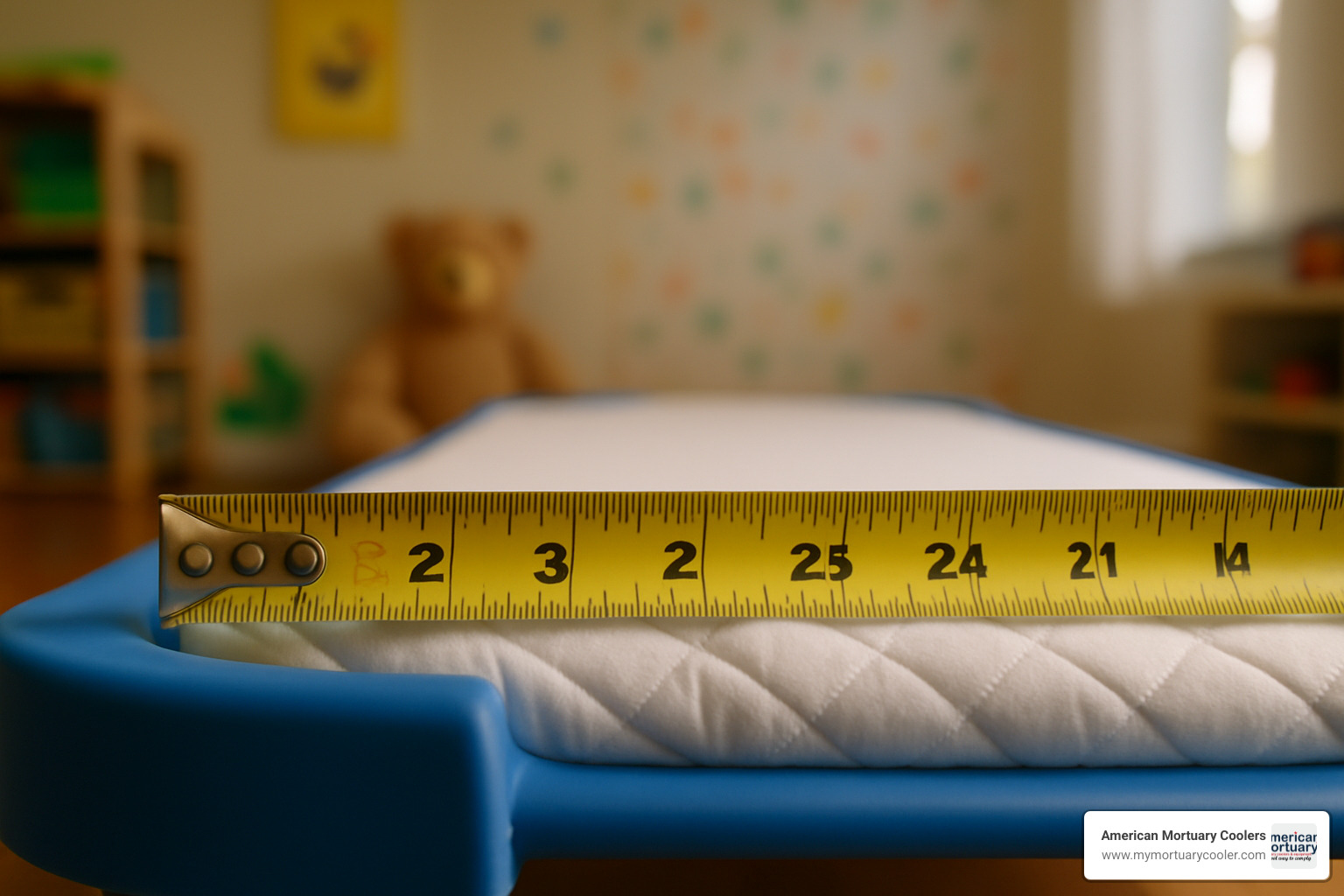
Here's the truth about cots sheets: getting the size wrong isn't just annoying—it can actually be dangerous. A sheet that's too small will pop off corners during naptime, leaving children on bare surfaces. Too large, and you've got bunched-up fabric creating uncomfortable lumps and potential safety hazards.
The 52" x 22" toddler cot size has become the gold standard in daycare centers across America. Walk into almost any preschool from Tennessee to California, and you'll find this dimension dominating the nap room. The MyPerfectClassroom Cot Sheet uses these exact measurements and includes four reinforced elastic corner loops that actually stay put.
But if you're dealing with camping or RV situations, you'll want the 30" x 75" narrow twin size. This longer, narrower dimension fits most camping cots and RV bunks perfectly. The Gilbins Cot Size sheet in this dimension has earned a solid 4.4-star rating on Walmart, with reviewers consistently praising how it transforms uncomfortable camping setups into cozy sleeping spaces.
Custom sizes are where things get interesting. After years of working with facilities across eight states, we've learned that professional equipment rarely follows standard home dimensions. Sometimes you need something completely unique, and that's perfectly normal in our industry.
For detailed sizing charts and professional recommendations, our complete guide to cot bed sheet sizes and dimensions covers everything from specialty measurements to industry standards.
Measuring Tips & Common Mistakes
The biggest mistake people make? Forgetting about mattress thickness. We see this constantly—someone measures the top surface and orders sheets, only to find their 4-inch thick mattress needs way more fabric to wrap underneath properly. Always measure the depth and add at least 4 inches for secure tucking.
Shrinkage allowance will save you headaches down the road. Even pre-shrunk cotton can lose 3-5% of its size after that first wash cycle. Buy slightly larger than your measurements, and thank yourself later.
Brand variations can throw you for a loop too. Community Playthings makes beautiful furniture, but their sheets are designed exclusively for their own cots. What works perfectly on their equipment might leave you struggling with ill-fitting bedding on other brands.
Ensuring Secure Attachment
Corner elastics make or break any fitted cot sheet—literally. The Happi-Nappi brand uses 1-inch wide elastic on all corners with reinforced stitching that won't rip out after a few washes. This attention to detail is exactly why they can confidently offer a 3-year warranty.
Snap loops offer an interesting alternative, especially for cots with unusual corner shapes or metal frames. Some manufacturers combine both elastic corners and snap attachments for maximum security, which works particularly well in high-use environments.
Try this simple slip test after installing any new sheet: grab a corner and try to pull it off. A properly fitted sheet should resist your efforts and snap back into place when released. If it comes off easily, you've either got the wrong size or a poorly constructed product that won't last through regular use.
Materials & Special Features to Look For
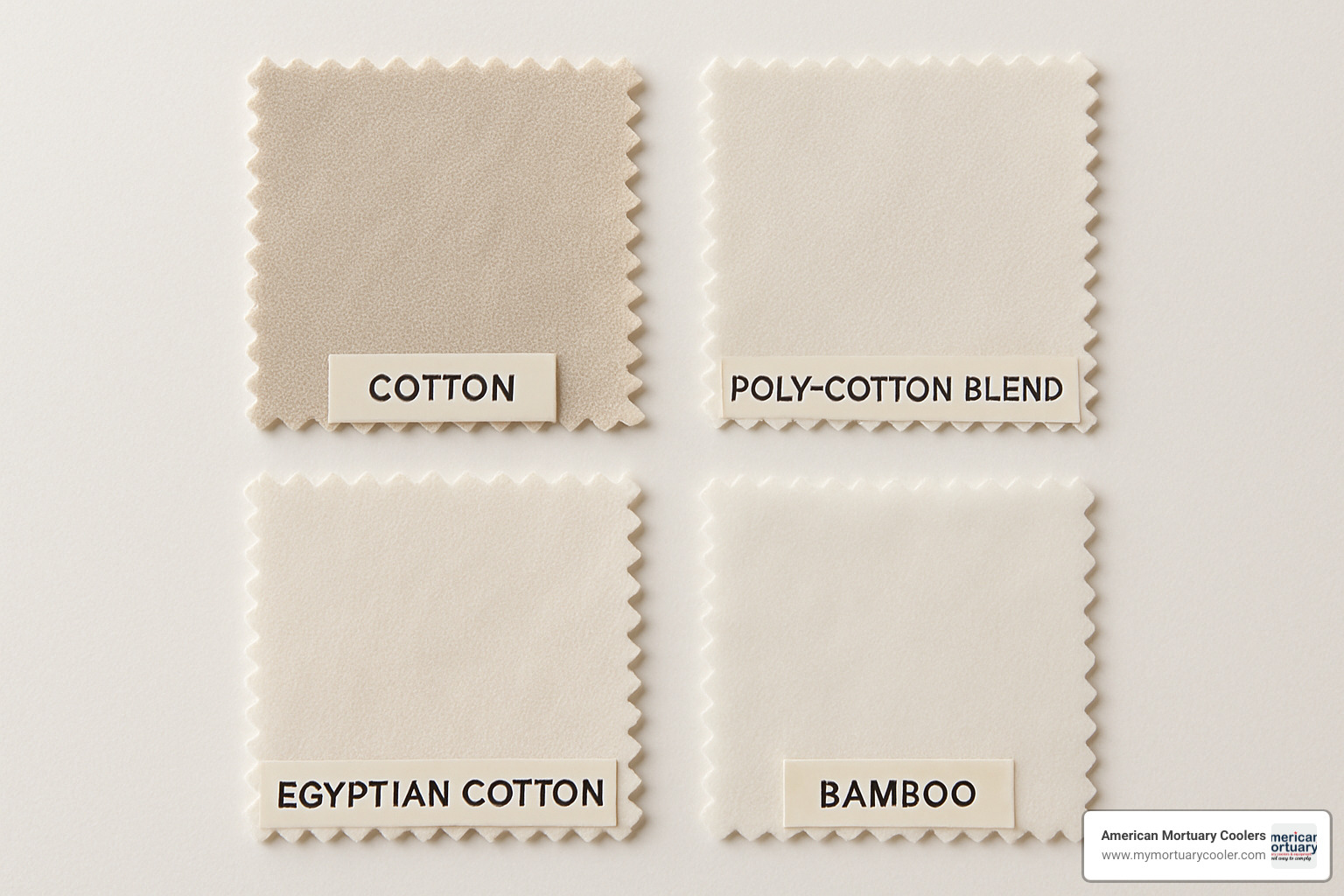
Choosing the right material for your cots sheets can make the difference between bedding that lasts years and sheets that fall apart after a few washes. After working with facilities across the country, we've seen how material choice affects everything from comfort to maintenance costs.
Poly-cotton blends are the workhorses of the cot sheet world. These 50/50 combinations, like those used in MyPerfectClassroom sheets, give you the best of both worlds - cotton's softness with polyester's durability. They wash easily, dry quickly, and resist wrinkles.
100% cotton feels wonderful against the skin and breathes beautifully, making it perfect for children who run warm during naps. Egyptian cotton cot sheets represent the premium end of this category, with over 200 units flying off Amazon's virtual shelves each month. The downside? They need more careful handling and can shrink if you're not careful with washing.
Bamboo fabric is becoming increasingly popular, and for good reason. It naturally fights bacteria and wicks moisture away from the body, keeping little ones comfortable throughout their rest time. While the initial cost is higher, many facilities find bamboo sheets outlast other materials.
For colder climates or chilly classrooms, flannel provides cozy warmth that children love. The brushed surface traps air, creating a natural insulation layer that's perfect for winter naps.
Microfiber offers excellent value for budget-conscious facilities. It's incredibly durable and resists stains, though some find it feels less natural than cotton blends.
Here's something many people get wrong about thread count - higher isn't always better for cot sheets. Around 200 thread count hits the sweet spot between comfort and durability. Going much higher often means paying more without getting better performance in commercial settings.
Stain-resistant treatments are absolute lifesavers in daycare environments. Some 65/35 poly-cotton blend sheets come with these finishes built in, making cleanup after accidents much easier and helping sheets look newer longer.
Scientific research on hypoallergenic fabrics shows that proper fabric selection can significantly reduce allergic reactions and improve sleep quality for sensitive children. Hypoallergenic fabrics deserve serious consideration, especially given how many children deal with sensitivities today.
Eco-Friendly & Sustainable Options
More facilities are asking about environmentally responsible options. Organic cotton with GOTS certification (Global Organic Textile Standard) ensures the cotton was grown without harmful pesticides and processed using environmentally responsible methods.
Recycled polyester offers an interesting compromise - some manufacturers now create the polyester component from recycled plastic bottles. You get the durability benefits while reducing waste.
Premium Add-Ons & Warranties
Some features are worth paying extra for, especially if you're outfitting a large facility. Attached top sheets, like those in the Happi-Nappi model, eliminate the need for separate top bedding. This design speeds up bed-making dramatically and means fewer pieces to lose or mismatch.
The 3-year Happi-Nappi warranty stands out dramatically in an industry where most sheets come with minimal or no warranty coverage. This kind of confidence in durability reflects superior construction and materials.
Antimicrobial finishes provide additional protection against bacteria and odors, particularly valuable in high-use environments. These treatments typically survive dozens of wash cycles when properly maintained, making them a worthwhile investment for busy facilities.
Choosing Cots Sheets for Every Setting
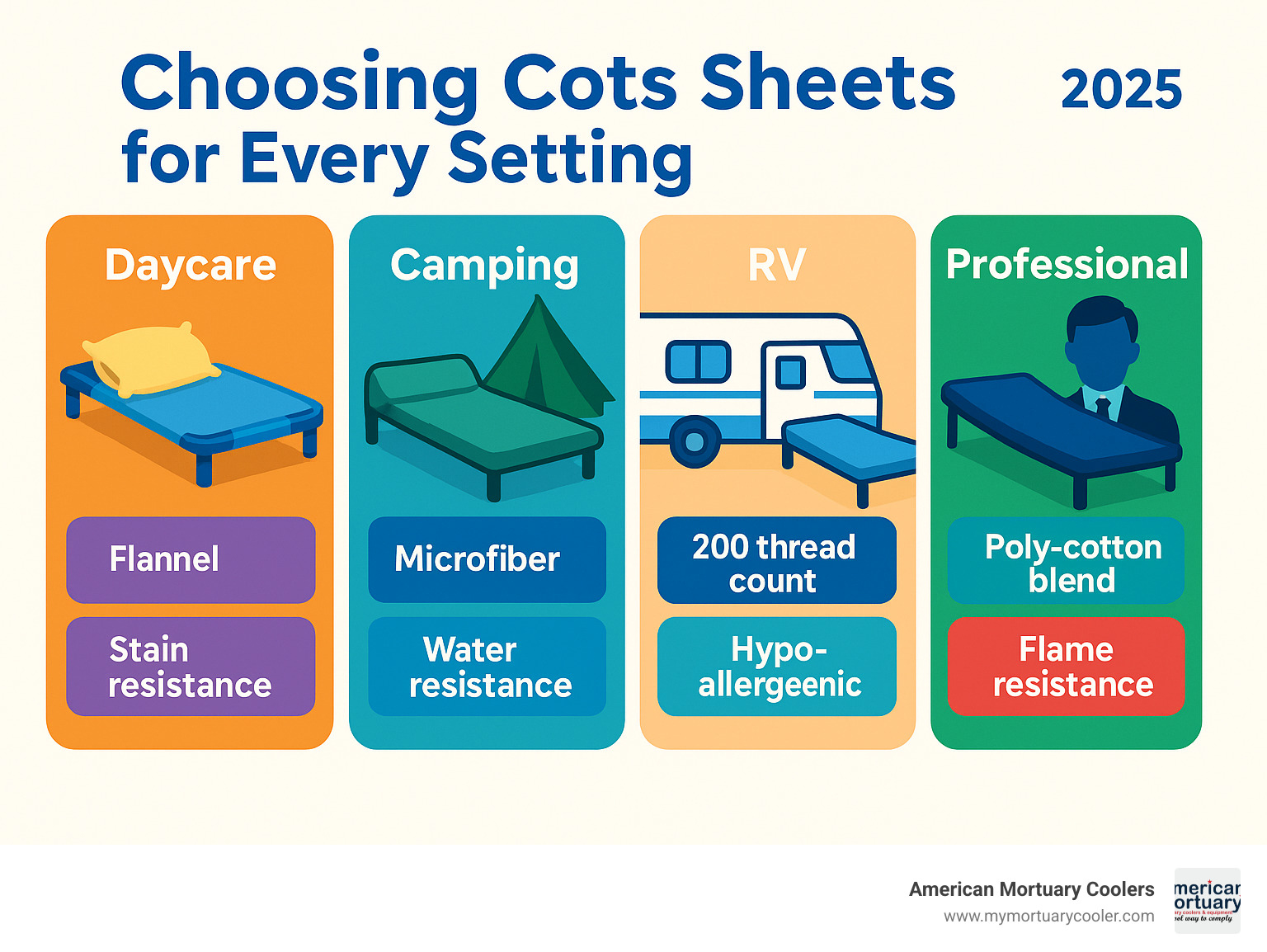
Not all cots sheets are created equal, and what works perfectly in your home guest room might be a disaster in a busy daycare center. We've learned this lesson through years of helping facilities across Tennessee, Georgia, and beyond find the right solutions for their unique needs.
The key is matching your sheet choice to your specific environment. A camping enthusiast needs completely different features than a daycare director, and both have different requirements than professional facilities.
Daycare & Preschool Needs
If you've ever tried to manage naptime for twenty toddlers, you know that easy identification colors aren't just nice to have - they're essential for sanity. The Lakeshore Cot Sheets have become popular partly because teachers can tie-dye them with craft paint. One creative teacher told us that after tie-dyeing sheets with craft paint, "each child had a unique color; after washing, the colors held and kids loved them."
Bulk wash cycles put sheets through punishment that home use never could. We're talking daily washing in commercial machines with harsh detergents and high heat. The American Baby Company Cotton-Polyester Blend Toddler Size Day Care Cot Sheet earns its 4.4-star rating by surviving this treatment day after day.
The real test comes with elastic durability. When your staff is stripping and remaking cots multiple times daily, cheap elastic will snap within weeks. Look for sheets with 1" wide elastic and reinforced attachment points.
Camping & Travel Considerations
Mother Nature doesn't care about your laundry schedule, which is why quick-dry properties top the list for outdoor trips. Poly-cotton blends typically dry faster than 100% cotton, and when you're dealing with morning dew or unexpected rain, that difference matters.
Wrinkle-resistance becomes your best friend when ironing isn't an option. The polyester component in blends naturally resists wrinkles, so your sheets look decent even after being stuffed in a duffel bag for hours.
Compact packing might seem minor until you're trying to fit everything into your RV or backpack. Quality camping sheets compress well without creating unnecessary bulk. The Gilbins Cot Size sheet specifically targets the 30" x 75" narrow twin market with ultra-soft cotton construction designed for camp bunk beds and RVs.
Home & Guest Set-Ups
When guests visit your home, decor style suddenly matters more than institutional durability. Many manufacturers now offer cots sheets in colors and patterns that complement home decor rather than screaming "daycare center."
Having spare sets isn't just convenient - it's essential. Nothing's more embarrassing than guests arriving to find their bed unmade because the only sheet is in the wash. At minimum, keep two sets so one can be in use while the other gets cleaned.
Specialty & Professional Use (Mortuary, Medical)
Professional environments have non-negotiable requirements that go far beyond comfort and convenience. Bio-barrier sheets serve critical functions in medical and mortuary applications, preventing fluid penetration and providing necessary hygiene barriers that protect both staff and equipment.
Fluid resistance isn't optional in these settings - it's a safety requirement. Professional-grade sheets often incorporate waterproof barriers or fluid-resistant treatments that would be overkill in other applications but are absolutely essential here.
Regulation sizes may be mandated by industry standards or local health departments. At American Mortuary Coolers, we understand the importance of compliance with industry standards across all our service regions. Getting the wrong size isn't just inconvenient - it can mean failing inspections or compromising safety protocols.
For facilities needing specialized equipment beyond just sheets, our comprehensive guide on buying a mortuary cot covers the broader equipment considerations that professional facilities need to address.
Care, Cleaning & Longevity of Cots Sheets
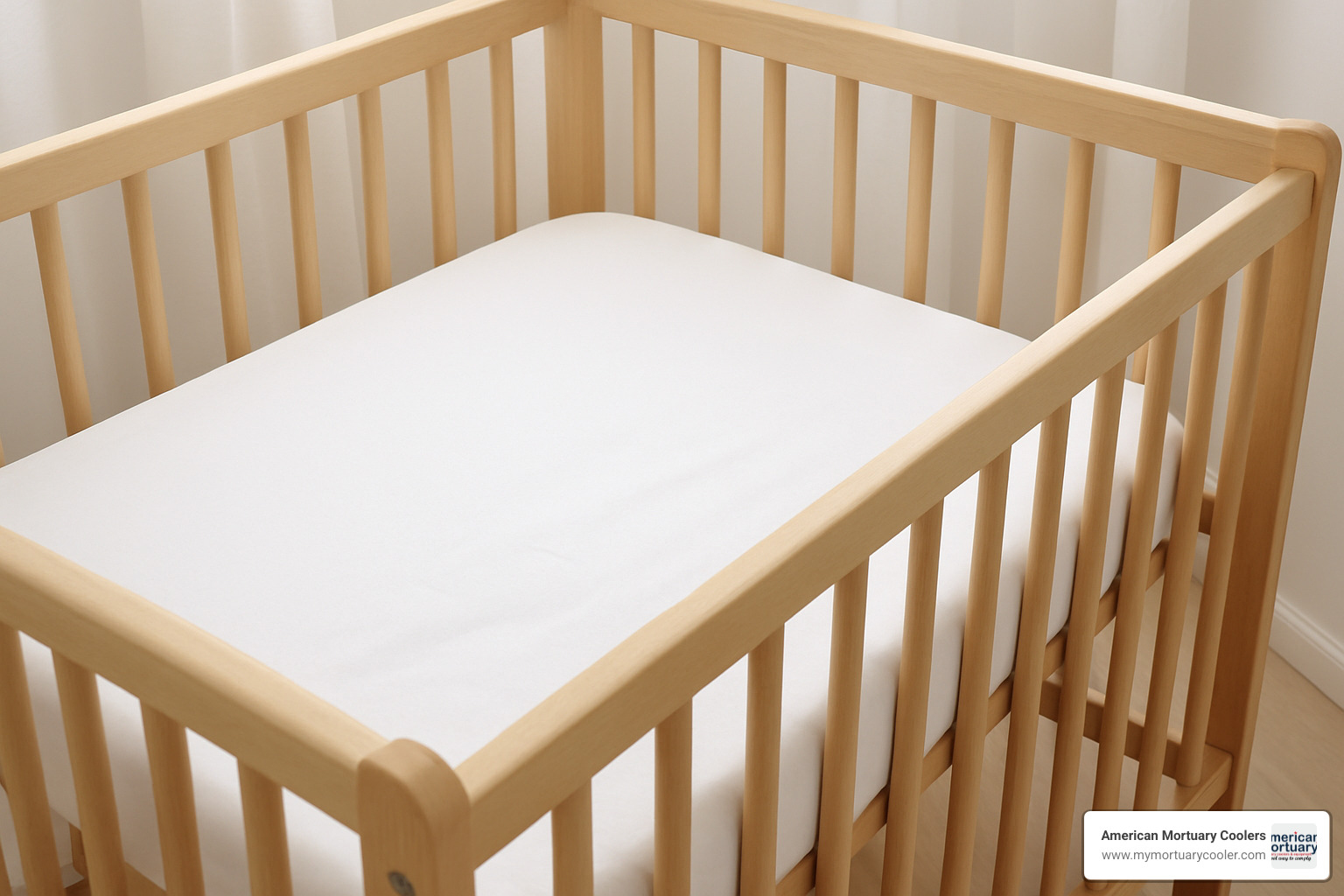
The secret to making your cots sheets last years instead of months? It's all in how you treat them from day one. We've seen facilities get five years out of quality sheets while others replace theirs every six months - and the difference usually comes down to washing techniques.
Pre-washing your new sheets might seem like an extra step, but it's actually one of the smartest things you can do. This first wash removes all those factory chemicals and sizing agents that make new sheets feel stiff and less absorbent. Plus, it lets cotton fibers settle into their final size before you start using them regularly.
Warm water hits the sweet spot for most cleaning needs. It's hot enough to kill bacteria and remove everyday stains, but gentle enough to preserve your fabric's integrity. The MyPerfectClassroom sheets specifically recommend warm water washing, and there's good reason for that recommendation.
When you need extra cleaning power, non-chlorine bleach is your friend. Regular chlorine bleach might seem stronger, but it's actually harsh enough to break down fibers and fade colors prematurely. Non-chlorine alternatives brighten whites and tackle stains without that destructive punch.
Tumble drying on low prevents the dreaded shrinkage surprise. High heat might dry things faster, but it's also the fastest way to turn a perfectly fitted sheet into something that won't stay put. Low heat takes a bit longer but keeps your sheets fitting properly wash after wash.
Troubleshooting Wear & Tear
Pilling is that annoying fuzzy texture that makes sheets look old before their time. It happens when short fibers work loose and tangle together on the surface. Higher-quality fabrics resist pilling better, but when it does happen, a simple fabric shaver can restore that smooth feel.
Elastic failure is the death knell for fitted sheets. Once that elastic loses its stretch or snaps, your sheet becomes a flat sheet whether you wanted one or not. This is why quality matters - good sheets reinforce where the elastic attaches to prevent this frustrating failure.
Color fading doesn't have to be inevitable. Cold water washing helps preserve colors, and keeping sheets out of direct sunlight while drying makes a huge difference. Some fabrics naturally hold their color better than others, which is worth considering when making your initial purchase.
Shrinkage can turn a perfect fit into a too-small disaster. Here's a pro tip: if you're worried about shrinkage, intentionally pre-shrink new sheets by washing them once in hot water and drying on high heat. Then return to gentler care routines.
Extending Sheet Life Sustainably
A rotation system is like having insurance for your bedding. Three sets of sheets means one in use, one in the laundry, and one ready to go. This approach distributes wear evenly and means you're never caught without clean sheets when you need them most.
Cold-water washing deserves serious consideration, especially with today's advanced detergents. You'll save energy, reduce fabric stress, and still get excellent cleaning results.
Line drying is the gentlest option for your sheets and the planet. Yes, they might feel a bit stiffer than machine-dried sheets, but they'll also last significantly longer.
Frequently Asked Questions About Cots Sheets
We get these questions all the time from daycare directors, camp managers, and families setting up guest rooms. After years of helping facilities across Tennessee, Georgia, and beyond, these are the answers that really matter.
What size sheet fits my 52" × 22" toddler cot?
Here's the thing - a standard 52" x 22" cot sheet should fit your toddler cot perfectly, but don't just assume it will. We've seen too many frustrated daycare workers struggling with sheets that looked like the right size but didn't fit properly.
Always measure your specific cot first. Some manufacturers call their cots "standard" but use dimensions like 50" x 21" or 51" x 22". That one-inch difference can mean the difference between a snug fit and a sheet that pops off the corners every time a child rolls over.
The sheet should have at least 4-6 inches of depth to wrap under the mattress and stay secure. If your cot has a thicker mattress - say 4 inches instead of 2 - you'll need deeper pockets to maintain that secure fit. This is especially important for safety in daycare settings where loose bedding can create hazards.
Which fabric keeps kids coolest in summer?
100% cotton or cotton-rich blends are your best friends when temperatures climb. Cotton naturally breathes, allowing air to circulate and moisture to evaporate. The MyPerfectClassroom sheets with their poly-cotton blend work well because they maintain cotton's breathability while adding durability.
Bamboo fabric is becoming our top recommendation for hot climates. It naturally wicks moisture away from skin and feels cool to the touch. While bamboo sheets cost more upfront, parents and daycare providers tell us kids sleep better and wake up less sweaty during summer naps.
Avoid heavy flannel or high-polyester content fabrics when it's hot. We've had daycare directors switch from flannel winter sheets to cotton summer ones and immediately notice kids sleeping more soundly during afternoon rest time. The difference in comfort is that noticeable.
How many cots sheets should a daycare keep on hand?
At least three sheets per cot - this is non-negotiable for smooth operations. One sheet stays on the cot, one goes in the wash, and one sits in reserve for emergencies. Trust us, emergencies happen daily in daycare settings.
High-use facilities often need four or five sets per cot to handle busy periods. When you've got 20 toddlers and three of them have accidents on the same day, you'll be grateful for those extra sheets. Plus, commercial washing schedules don't always align with your immediate needs.
We've worked with daycare centers that tried to get by with just two sets per cot. They quickly learned that one delayed laundry cycle or one busy accident-prone day can leave them scrambling. The small extra investment in additional cots sheets pays for itself in reduced stress and maintained hygiene standards.
Bulk purchasing also makes financial sense. Many suppliers offer better pricing when you order complete sets for your entire facility rather than buying individual sheets as needed.
Conclusion & Next Steps
After diving deep into cots sheets, you're now equipped with everything needed to make the right choice for your specific situation. Whether you're a daycare director in Georgia looking for durable sheets that can handle daily washing, a camping enthusiast in Texas seeking quick-dry options for your RV trips, or managing professional facilities that require specialized bedding solutions, the perfect sheet is out there waiting for you.
The journey through sizing, materials, and care instructions might seem overwhelming at first, but getting it right the first time saves both money and headaches down the road. We've seen too many facilities struggle with ill-fitting sheets that slip off corners or cheap materials that fall apart after a few washes.
For daycare and preschool environments, durability should be your north star. Those poly-cotton blends with reinforced elastic corners might cost a bit more upfront, but they'll survive the daily strip-and-wash routine that's part of childcare life. The easy identification colors we discussed can transform chaotic nap time into a smooth operation where every child knows exactly which cot is theirs.
Camping and travel enthusiasts will find their sweet spot with those 30" x 75" quick-dry options. There's nothing quite like crawling into a comfortable, properly fitted sheet after a long day of hiking, knowing it'll be dry and ready to pack tomorrow morning.
Professional applications require a different level of attention to detail. At American Mortuary Coolers, our years of experience across Tennessee, California, New York, and beyond have taught us that professional-grade equipment - including something as seemingly simple as cot sheets - must meet specific standards and regulations. The bio-barrier and fluid-resistant options we covered aren't just nice-to-have features; they're essential for maintaining industry compliance and operational excellence.
Here's the truth we've learned from working with facilities across the contiguous 48 states: the cheapest option rarely delivers the best value. Those bargain sheets that seem like a great deal often end up costing more in the long run through frequent replacements, poor fit, and operational disruptions.
Quality cots sheets do more than just cover a sleeping surface. They create barriers against germs, provide comfort that promotes better rest, and contribute to the smooth operation of your facility. Whether you choose the Happi-Nappi with its impressive 3-year warranty or the tried-and-true Lakeshore options with their 4.6-star ratings, investing in proper bedding pays dividends in performance and peace of mind.
For those managing specialized professional environments, don't hesitate to consult with equipment specialists who understand your unique requirements. Our comprehensive guide on finding the best cover for cot applications provides additional insights that can help you steer the more technical aspects of professional bedding solutions.
The right cot sheets are out there, ready to transform your sleeping arrangements from adequate to exceptional. Take the time to measure carefully, choose quality materials, and select the features that match your specific needs. Your future self - and anyone who uses those cots - will thank you for the thoughtful investment.
















